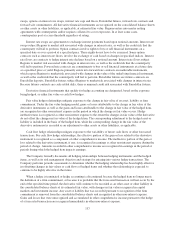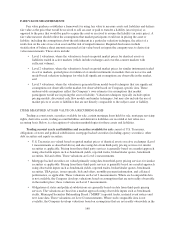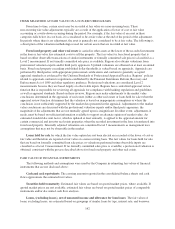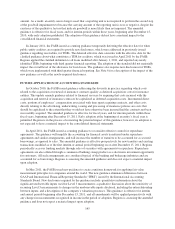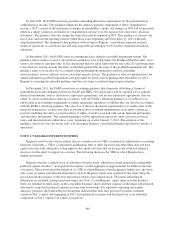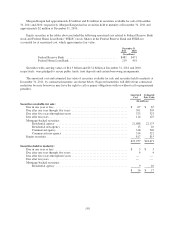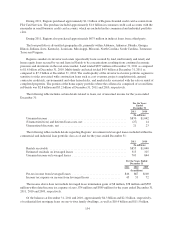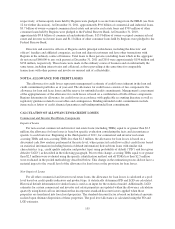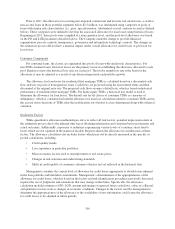Regions Bank 2011 Annual Report Download - page 170
Download and view the complete annual report
Please find page 170 of the 2011 Regions Bank annual report below. You can navigate through the pages in the report by either clicking on the pages listed below, or by using the keyword search tool below to find specific information within the annual report.In June 2011, the FASB issued new guidance amending disclosure requirements for the presentation of
comprehensive income. The guidance eliminates the option to present components of other comprehensive
income (“OCI”) as part of the statement of changes in shareholders’ equity. All changes in OCI will be presented
either in a single continuous statement of comprehensive income or in two separate but consecutive financial
statements. The guidance does not change the items that must be reported in OCI. This guidance is effective for
fiscal years and interim reporting periods within those years beginning after December 15, 2011 with early
adoption permitted. The adoption of this guidance will not impact Regions’ consolidated financial position,
results of operations or cash flows and will only impact the presentation of OCI in the consolidated financial
statements.
In September 2011, the FASB issued accounting guidance related to goodwill impairment testing. The
guidance allows entities to elect to first perform qualitative tests to determine the likelihood that the entity’s fair
value is less than its carrying value. If it is determined that it is more likely that the fair value of a reporting entity
is less than its carrying amount, the entity would then perform the first step of the goodwill impairment test. The
guidance refers to several factors to consider when performing the qualitative analysis, including:
macroeconomic factors, industry factors, and entity-specific factors. The guidance is effective prospectively for
annual and interim goodwill impairment tests performed for fiscal years beginning after December 15, 2011.
Regions is assessing the amended guidance and does not expect a material impact upon adoption.
In December 2011, the FASB issued new accounting guidance that eliminates offsetting of financial
instruments disclosure differences between GAAP and IFRS. New disclosures will be required for recognized
financial instruments, such as derivatives, repurchase agreements, and reverse repurchase agreements, that are
either (1) offset on the balance sheet in accordance with the FASB’s offsetting guidance or (2) subject to an
enforceable master netting arrangement or similar agreement, regardless of whether they are offset in accordance
with the FASB’s offsetting guidance. The objective of the new disclosure requirements is to enable users of the
financial statements to evaluate the effect or potential effect of netting arrangements on an entity’s financial
position, including the effect or potential effect of rights of setoff associated with certain financial instruments
and derivative instruments. This amended guidance will be applied retrospectively and is effective for fiscal
years, and interim periods within those years, beginning on or after January 1, 2013. The adoption of this
guidance, which involves disclosure only, will not impact Regions’ consolidated financial position or results of
operations.
NOTE 2. VARIABLE INTEREST ENTITIES
Regions is involved in various entities that are considered to be VIEs, as defined by authoritative accounting
literature. Generally, a VIE is a corporation, partnership, trust or other legal structure that either does not have
equity investors with substantive voting rights or has equity investors that do not provide sufficient financial
resources for the entity to support its activities. The following discusses the VIEs in which Regions has a
significant interest.
Regions owns the common stock of subsidiary business trusts, which have issued mandatorily redeemable
preferred capital securities (“trust preferred securities”) in the aggregate of approximately $1 billion at the time
of issuance. These trusts meet the definition of a VIE of which Regions is not the primary beneficiary; the trusts’
only assets are junior subordinated debentures issued by Regions, which were acquired by the trusts using the
proceeds from the issuance of the trust preferred securities and common stock. The junior subordinated
debentures are included in long-term borrowings (see Note 12) and Regions’ equity interests in the business
trusts are included in other assets on the consolidated balance sheets. Interest expense on the junior subordinated
debentures is reported in interest expense on long-term borrowings. For regulatory reporting and capital
adequacy purposes, the Federal Reserve Board has indicated that such trust preferred securities currently
constitute Tier 1 capital, but beginning in 2013, trust preferred securities will be phased out as an allowable
component of Tier 1 capital over a three-year period.
146



